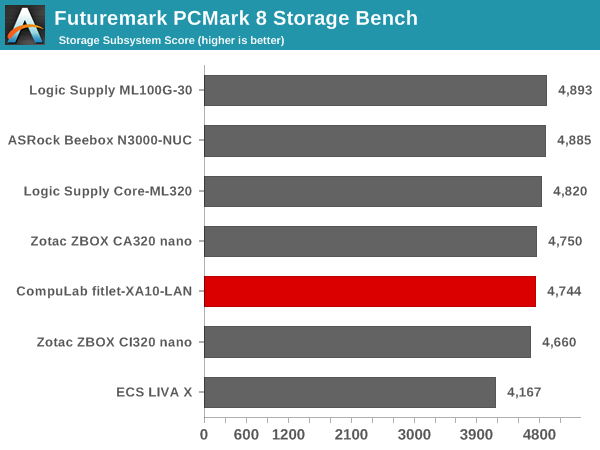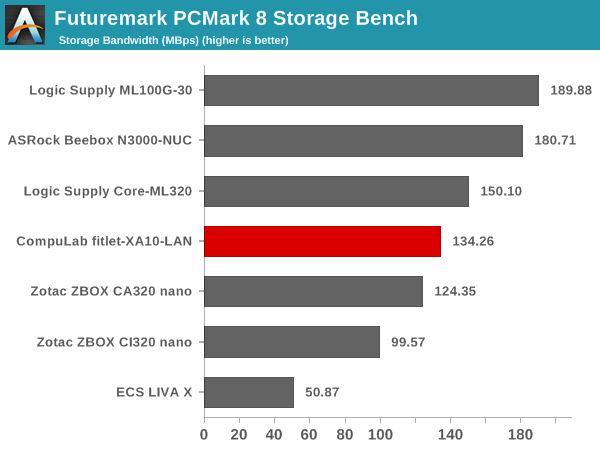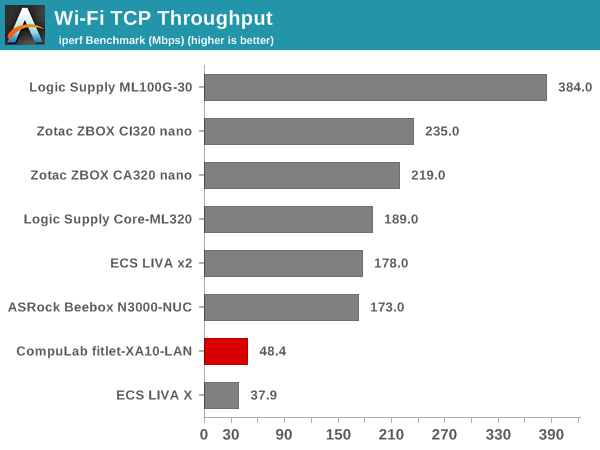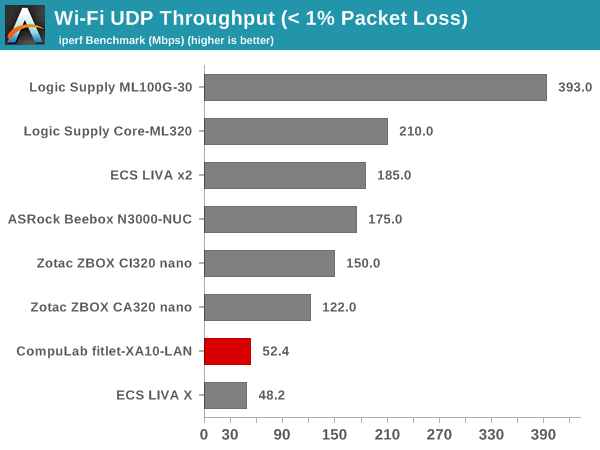Compulab fitlet-XA10-LAN Review: A Fanless AMD UCFF PC for Networking Applications
by Ganesh T S on April 19, 2016 8:00 AM EST- Posted in
- Systems
- Networking
- AMD
- Fanless
- Industrial PC
- Passive Cooling
- CompuLab
Wireless Networking and Storage Performance
Networking and storage are two major aspects which influence our experience with any computing system. This section presents results from our evaluation of these aspects in the CompuLab fitlet-XA10-LAN. On the storage side, one option would be repetition of our strenuous SSD review tests on the drive(s) in the PC. Fortunately, to avoid that overkill, PCMark 8 has a storage bench where certain common workloads such as loading games and document processing are replayed on the target drive. Results are presented in two forms, one being a benchmark number and the other, a bandwidth figure. We ran the PCMark 8 storage bench on selected PCs and the results are presented below.


The Micron RealSSD C400v is a mSATA drive based on the Marvell 88SS9174 controller. It is quite old, considering that we reviewed it back in 2012. However, it does come with 25nm MLC flash, and is rated for a 36TBW workload. Practically speaking, it stands head-to-head with modern SSDs when it comes to performance for day-to-day applications.
On the networking side, we restrict ourselves to the evaluation of the WLAN component in this section. Our standard test router is the Netgear R7000 Nighthawk configured with both 2.4 GHz and 5 GHz networks. The router is placed approximately 20 ft. away, separated by a drywall (as in a typical US building). A wired client (Zotac ID89-Plus) is connected to the R7000 and serves as one endpoint for iperf evaluation. The PC under test is made to connect to either the 5 GHz (preferred) or 2.4 GHz SSID and iperf tests are conducted for both TCP and UDP transfers. It is ensured that the PC under test is the only wireless client for the Netgear R7000. We evaluate total throughput for up to 32 simultaneous TCP connections using iperf and present the highest number in the graph below.

In the UDP case, we try to transfer data at the highest rate possible for which we get less than 1% packet loss.

Since the WLAN adapter is actually an external USB 2.0 device and has a 1x1 802.11n 2.4 GHz-only configuration, it is not surprising to see that the Wi-Fi performance is barely passable. That said, the WLAN component is fine for use as a management interface (which is likely, given the presence of four gigabit wired ports). It must also be noted that the fitlet-X LAN sacrifices WLAN performance in favor of LAN due to lack of space. The fitlet-i, targeting more traditional use cases, incorporates Intel's AC7260 802.11ac chipset with dual antennae for significantly better Wi-Fi performance.










50 Comments
View All Comments
ingwe - Tuesday, April 19, 2016 - link
This may be a naive question, but would this work as an HTPC? I would love a fanless solution for that and this seems to offer decent performance.monstercameron - Tuesday, April 19, 2016 - link
h.264 8bit 1080p, it could work but dont expect super high bit rates to work.unproven - Tuesday, April 19, 2016 - link
The ancient Zbox Nano AQ01 with an A4-5000 runs my 1080 display flawlessly - never a decoding single while streaming, including every H265 file I've tried.Old low power cores lack in ST performance so interfaces don't always "snap", but this thing should have no troubles at all with FHD TV.
BurntMyBacon - Tuesday, April 19, 2016 - link
Performance-wise it could be used as an HTPC. That said, you'd be better off considering a different variation of the fitlet unless you have a pressing need for all the networking ports.Caveats: The fitlets I had got VERY hot. I found the same results over multiple units and more than one variation of the fitlet, so I don't believe it to be a one off issue. I put them on top of mesh shelving and ran a fan on them as they would discolor the surface of the shelve they sat on over time. They had shallow fins on the top, so I believe they were second revision. The new heatsink may fix this problem.
That all said, you'd probably be better off looking at some of the other offerings from the same company. My experience with the Intense-PC3 and Intense-PC4 have been very positive. They aren't as small as fitlets, but they are still smaller than many consumer grade routers and they don't have the heat issues.
BurntMyBacon - Tuesday, April 19, 2016 - link
Correction - I've had positive experiences with the Fit-PC3 and Fit-PC4. Haven't had the pleasure of using an Intense-PC.ct909 - Tuesday, April 19, 2016 - link
An Intel NUC might not be fanless, but I'm damned if I can ever hear it, and would be a much better HTPC. You could even consider an Intel compute-stick.at80eighty - Tuesday, April 19, 2016 - link
look at the Minix NEO U1 - fanless; 4k, 60fps, 10bit, HEVCraddude9 - Thursday, April 21, 2016 - link
I would look at a different model of the Fitlet for HTPPC purposes. They have a version with just one Ethernet port for $15 less and one with the slightly slower A4 Micro-6400T chip for $69 less. Both of those probably put out less heat so would be more suitable for HTPC applications.Compulab - Thursday, April 21, 2016 - link
6400T is indeed significantly lower cost than 6700T, but for a given workload the 6700T would be lower-power since for a given frequency it can run at lower core voltage.pekpetrolhead - Friday, April 22, 2016 - link
Youy might want to consider a Giada F300. Fanless (whole chassis is a heatsink), i5 - great unit allround.